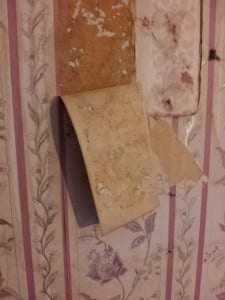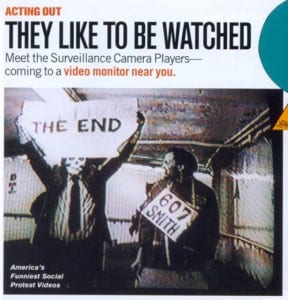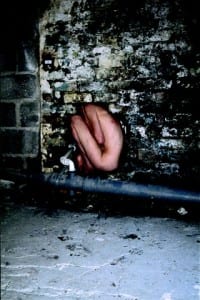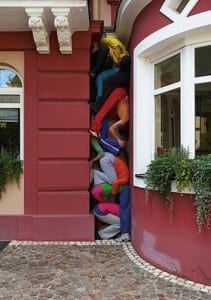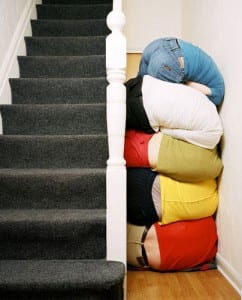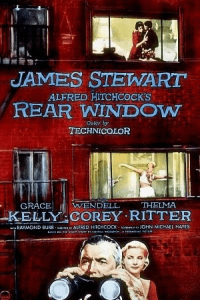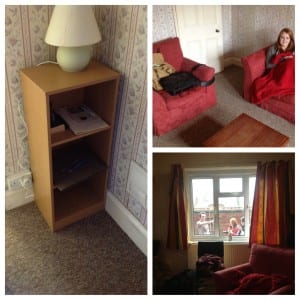
Photo taken 01/02/2013 by Jozey Wade
Heathcote makes an interesting point in his book that the bathroom is “as brutally honest a reflection of our domestic concerns as the bathroom mirror (is) of our bodies” ((Heathcote, E (2012) The Meaning Of Home, London: Frances Lincoln)). He rightly suggests that the bathroom is the only room in which there is no pretense; when you walk in you see a bath, you see a sink and (although in a separate room in our house) you see a toilet. There are no questions about what these things are used for; as raw and maybe even slightly unpleasant as these usages may be (particularly with the toilet), they are right in our faces as we enter. He says the bathroom is “fundamentally modest and unpretentious” (2012, p. 83); it is there and it is what it is because we need it. We need to wash and we need to relieve ourselves. Perhaps even more interestingly he says the bathroom is a place with “nothing to hide and nowhere to hide it” (2012, p. 83). I found this particularly interesting when applying his ideas to the performance ideas I have been considering. This idea that we go in the bathroom and we lock the door and we take our clothes off. We are away from judgmental eyes, away from embarrassment. Alone. And naked. Not just without clothes but, as a woman, without make up, without hair gel or any of these things. In the bath we wash all the pretenses off and we are just our bare, honest self. What happens if we let an audience in to this raw, private environment? Don’t interact with them. Just let them watch. It breaks those boundaries we are so used to associating with a bathroom.
Here is where I go on to discuss my 3 ideas…
1. My first idea also relates to Heathcote’s chapter, where he talks about how “The Roman’s famously used the bathhouse as a space… of socialising” (2012, p. 81). The bathroom as part of the house and as a private place is quite a modern concept. In the not too far distant past, let alone the Roman times, baths were taken in the bedroom or downstairs beside the fire, in front of other people. Despite the fact that this wasn’t long a go, to our generation and even a couple of generations before us, the idea of this is utterly alien to us. The idea of bathing being a social activity… well, even to me, it is a concept that is extremely difficult to imagine. I like to be alone when I bathe, as I’m sure the rest of you do. In fact, if one of us was in a bath with someone else in this day and age, as an adult, it would almost definitely be to do with sex. So, my idea was to revert back to this concept of bathing being social. I intended to invite the audience in, almost as though it was the lounge, while I washed myself, even get fellow cast members to join me and chat with them and the audience. I thought it would be interesting to see what their reaction was, if they found it uncomfortable. As you can see in the picture below, I have begun to experiment with this (wearing swimwear at the moment).
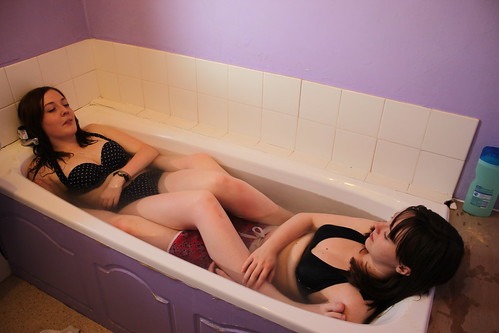 Photo taken 08/02/2013 by Jozey Wade
Photo taken 08/02/2013 by Jozey Wade
2. My second idea was inspired by Lital Dotan’s Glasshouse. The idea that she uses her entire house as a performative “exhibition space” ((Ortiz, Jen (2013) ‘Life as a Glass House’, Narratively, 25 January, accessed 30 January 2013, http://narrative.ly/2013/01/life-as-a-glass-house/<a href="http://www.whatsonstage.com/reviews/theatre/london/E8831330082708/Romeo+and+Juliet+(Headlong+tour+%96+Guildford,+Yvonne+Arnaud+Theatre).html")) seems quite unimaginable in itself, as a home as a whole is quite a private place. But, the idea of using the bathroom specifically as an exhibition struck me, partly because of this idea of a bathroom being private and, as Heathcote said, "brutally honest" ((Heathcote, E (2012) The Meaning Of Home, London: Frances Lincoln)). So I began to think of ways to turn the bathroom into an exhibition.
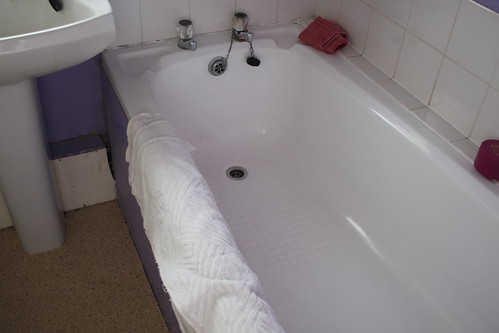 Photo taken 08/02/2013 by Jozey Wade
Photo taken 08/02/2013 by Jozey Wade
The empty bath (as can be seen above), when I look at is, is almost asking to be filled. It is there to be filled. But what if it wasn’t filled with water but with memories? Memories of bathroom experiences… which of course are usually private, but for our performance, are put on exhibition. So, things like photographs of bath time memories (both “normal” and sinister), notes which contain snippets of bathroom memories, toys people play with in the bath (like rubber ducks, but maybe even adult toys) and more (I am trying to think of things all the time, and certainly open to suggestions). So the bath would be an exhibition of memories of a place that is usually so personal and private – full of them. I then thought about the idea of projecting something on the wall, perhaps snippets of video memories of the bath (which I am already in the process of filming – again both “normal” and sinister). Although, it might be interesting to project these videos onto the bath full of “junk” and see how it looks. I have decided, for now, that I will probably use this idea for two out of the four nights and the other two nights I will perform something live…
Here is an example of a “normal” and more sinister bathroom photograph I have been taking to build up a selection to fill the tub with:
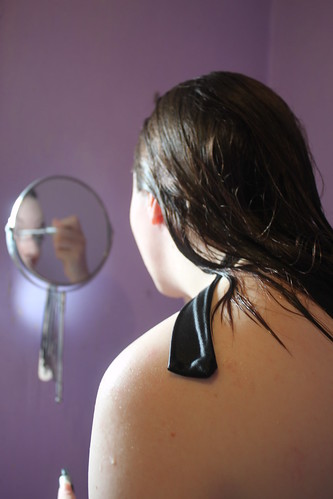
Photo taken 08/02/2013 by Jozey Wade
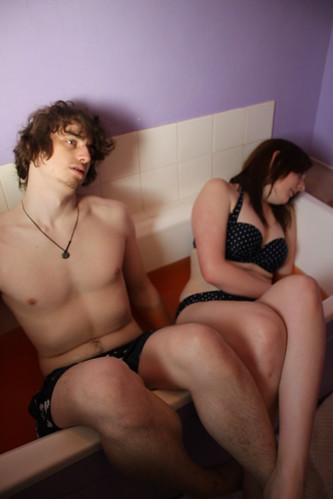
Photo taken 08/02/2013 by Jozey Wade
3. My third idea is still a work in progress. It wasn’t particularly originally inspired by anything other than the time I have spent in the bathroom, but it has now been enforced by what Heathcote said in his chapter, which I discussed at the start of this blog. It is the idea I touched upon of letting the audience into the bathroom (actually shutting them in – trapping them I suppose), not interacting with them or even acknowledging them, just letting them watch whatever it is that I do. I have been playing with different ideas of what I might do. I initially liked exploring the idea of madness, and the fact that bathrooms are places were many people commit suicide. The image of someone having cut their wrists in the bath, and also bathroom cabinets – often where the pills are kept, and the lock on the door, of course, meaning no one can get to the person should anything happen.
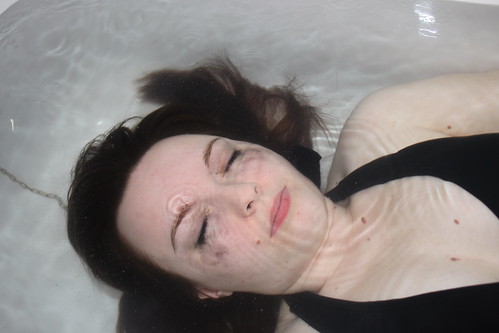 Photo taken 08/02/2013 by Jozey Wade
Photo taken 08/02/2013 by Jozey Wade
As in the picture above, I tried out saying snippets of Ophelia’s song from Hamlet (where she has gone mad, just before she drowns herself) under the water and also just lying there in the bath, with the intention of gathering bits of text from other sources (films, plays, personal experiences) and creating a mash up of text which I would say/ enact whilst in the bath. That was one idea. Other ideas have included me lying in the bath fully clothed, maybe not even having it full of water, but something else, or even nothing… so completely subverting what a bath is used for and creating that confusion/ unease for the audience. Another idea I like is to use the projector and project video onto the water… I would still be there and the performance would include more than just that but it was just a thought I liked for part of the performance. If I projected a video of me in the bath onto the bath water, would it create a ghost like image? I liked the idea of that. Any suggestions are welcome and I will continue to read around for inspiration, but also use the Tim Etchells technique of being in the space and seeing what happens/ comes out.
